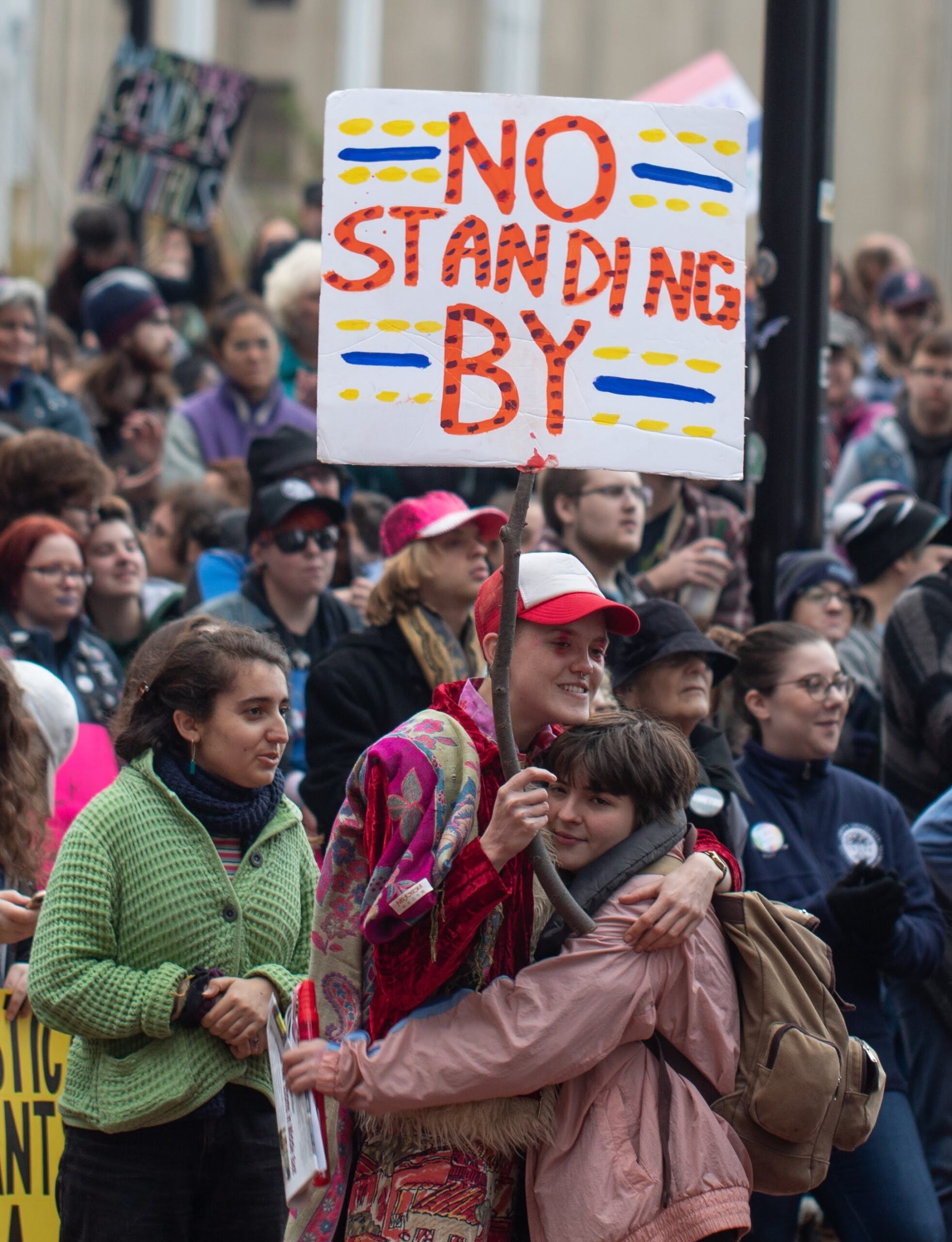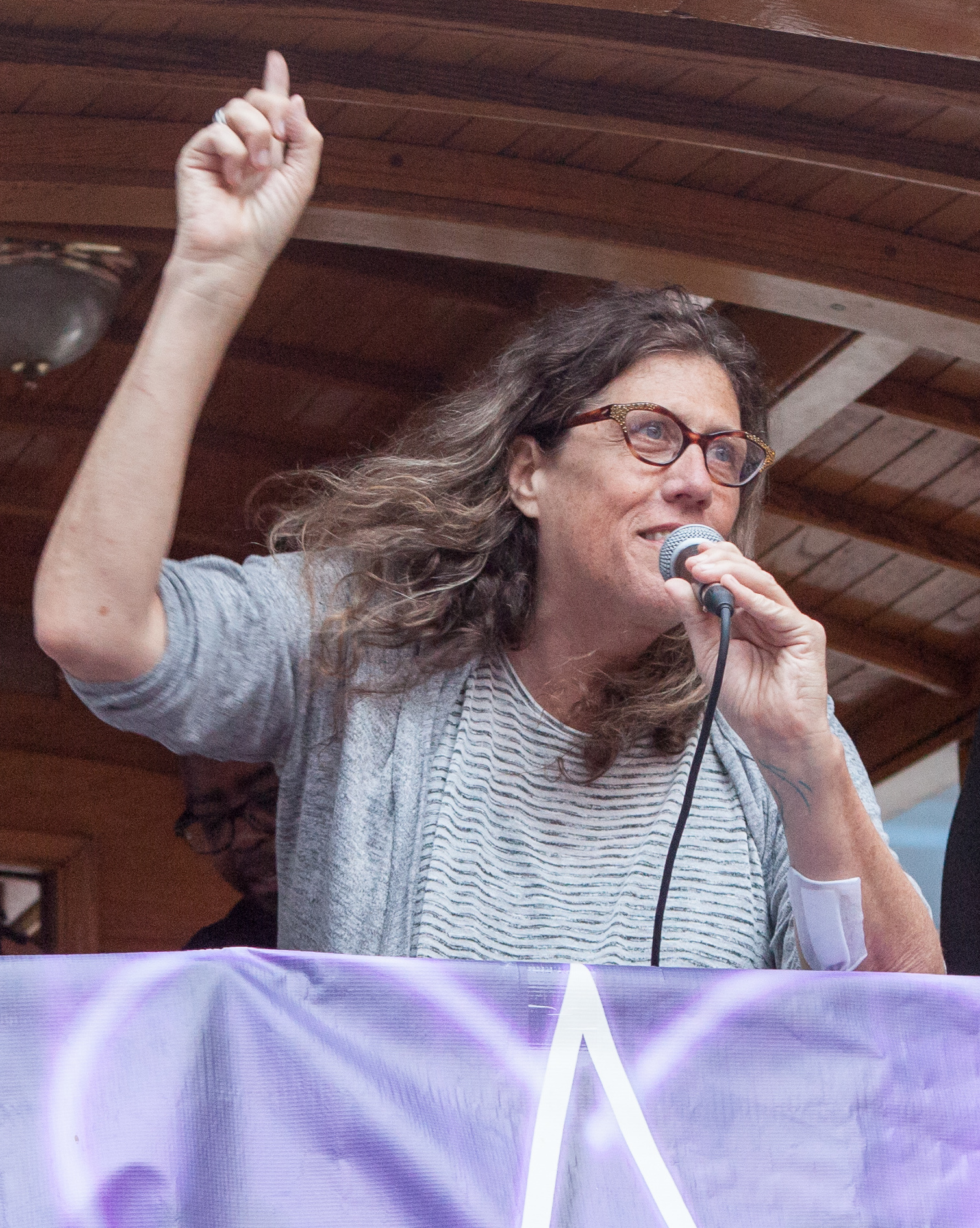
Featured Image: Boston 2018 Trans Rights Rally (Source: Kai Medina)
By Miguel von Fedak
CONTENT WARNING: This piece touches on themes of transphobia, sexual assault, and other forms of abuse that may be triggering for readers.
Rain Valdez was born in the capital city of the Philippines, Manila, and grew up with her mother and stepfather in Guam–an American territory in the Western Pacific where the vast majority of inhabitants are either native Chamorro or Filipino. Today, Valdez is a successful actress, producer, and writer. She was recently nominated for a Primetime Emmy. Like all the commentators in the Netflix documentary Disclosure: Trans Lives on Screen, Valdez is transgender.
Valdez’ love for cinema began as a young child. In Disclosure, she recounts watching the early 90’s movie Soapdish with her family. Towards the end, a mean-spirited female character is forcibly outed as a transgender woman. The revelation causes several characters to gasp in shock; a few faint; the man who had been romantically interested in her nearly vomits; and she herself flees in despair. The event ruins her career.
Disclosure cuts Valdez’ recounting of her story between scenes from Soapdish. I’ve thought about what it would be like to watch the horrific scene without Valdez’ emotional commentary. Of the 30 or so characters present for the outing, a few celebrate the revelation, a few faint, one almost vomits, the boss expresses anger, a few laugh, and others smile big. The inclusion of so many different reactions leads me to believe that the filmmakers weren’t trying to show how people tend to react to a transgender person being outed. It feels more appropriate to view each character’s reaction as a cue card–a heavy-handed suggestion for what viewers should do. Instead of “applause,” these cards read “disgust!” “anger!” “catharsis!”. However, Valdez’ voice stops us from blindly following these instructions. She does not tell us what to do. She does not deeply analyze the scene. She does not offer any fundamental reinterpretation. She sits there, reminding us that the makers of Soapdish chose to punish their character by making her trans.
Like nearly every anecdote shared throughout Disclosure, Valdez’ story demonstrates that American media has taken key facets of transgender identity–crossdressing, gender variance, different sexualities, bodily autonomy, and more–and employed them as tools to tell stories to cisgender audiences. When crossdressing psychopathic killers go on murder sprees in Silence of the Lambs and Dressed to Kill, they capitalize on cisgender fears and ignorance about transgender people. When cis actors crossdress in The Three Stooges and Mrs. Doubtfire, they play up the most ludicrous stereotypes to make fun of the idea of presenting as a different gender. When shows like House or Grey’s Anatomy include a transgender patient, their medical predicaments and complex health concerns–often directly related to their genitalia–baffle viewers, inspiring respect for the work of the hero doctors. When trans characters are forcibly and violently outed in movies like Ace Ventura and Soapdish, other characters’ ridiculous reactions–vomiting, fainting, laughing–play on cis viewers’ unease to generate catharsis.

When Disclosure’s narrators discuss the impact of inclusive and empowering representation, some discuss how humans tend to want to see their stories reflected back to them–how seeing one’s identity on a screen can make them feel more comfortable with their own story. I asked Susan Stryker, Yale visiting professor, theorist, writer, and producer, what role she envisions for trans representation. She said, “I love the Brecht quote: ‘Art is not a mirror held up to reality. It is a hammer with which to shape it.’” The first interpretation depends on audience. A great trans story can only reflect a trans person if that person reads, watches, or listens to that story. The second interpretation does not. As a hammer, any story can either meet reality where it is or bang it into a different shape–no matter who’s watching.
Disclosure benefits from having Laverne Cox as its executive producer, Sam Feder as its director, and dozens of trans creatives as its narrators. Having so many diverse and powerful trans voices at every level of production gives the film an incredible sense of self-awareness. Throughout the film, the commentators reference the current political climate, the economic and political injustices perpetrated against trans women of color, the privileges they hold, the historical spaces they occupy, the places they seek to go, and more. There is no commentator that indicates any misgivings about their intentions, their influence, and their experiences. Cameron Chacon, president of TransAtYale, identifies one area where the documentary seems to lack this self-awareness: “The documentary seems to orient itself to the outside, to a cis audience, but probably the group most likely to actually watch is trans people ourseleves. As such, I think the makers could have warned us, or at least indicated in some way, before rape scenes or very violent scenes are shown.” Disclosure’s commentators recognize how horrible and triggering the clips they show are, especially for the trans community. Many of them cry or even have to take a pause when analyzing and recounting their experiences with particularly horrifying and hurtful media. They sit there, reliving that suffering. In front of that backdrop, each commentator asks for more trans representation.
Laverne Cox, Jen Richards, and Nick Adams don’t each ask for more trans representation because they love to see cis people manipulate trans stories and create fantastical versions of trans people. They ask for more representation because the more there is the higher the chance becomes that someone will get it right, even though it will inevitably also lead to degrading as well as empowering representations. Transmasculine writer Tiq Milan notes, “The paradox of our representation is the more we are seen, the more we are violated.” The more that an issue or experience becomes a part of mainstream discourse, the more it becomes subject to scrutiny. Cameron Chacon underscores, “Media that is explicitly about transness… media that presents trans identity and sets trans people out in the open, vulnerable, to be examined and judged and reacted to by cis people scares me. Visibility is a double edged sword in that when we are seen we can also become targets.” Despite the backlash trans representation can incite, it can also hammer home some important ideas. It can transform how people view trans stories.

Disclosure ends by discussing some of the most recent, impactful, and profound transgender stories featured on television. Shows like Euphoria, The Politician, Pose, and Sense8 feature trans characters with complex storylines, agency, and unique relationships. Of these, Pose is the gold standard for its elaborate portrayal of power, class, race, and gender in 1980s New York City. I sense a shift in Disclosure when the commentators–notably when singer and actress MJ Rodriguez–begin to discuss the legacy and work of Paris is Burning and its role in influencing Pose. Rodriguez offers personal commentary like Valdez and others do, but Rodriguez has what Valdez lacks. Rodriguez has Pose. She has a piece of media that fortifies her voice, that entrenches the idea that it’s her story she tells for herself. Others may hear what she has to say, but she doesn’t say it for them.
Paris is Burning violated Black trans people by giving them the spotlight and keeping the spoils. It documented their stories, marketed them to the public, and found success in appropriating their art and methods of survival into a stylistic, mainstream trend. It’s no coincidence that Paris is Burning came out in 1991 when Madonna’s hit single Vogue came out in 1990. Pose tells the same evocative, powerful stories that Paris is Burning does, and it tells it with trans people of color at every level of production. Any success Pose enjoys will be felt by the same people Pose features.
I have never once felt Pose was made for me. I am a masculine-presenting, white person who grew up in Venezuela and goes to Yale. I don’t see my story reflected in the struggles of the queer community of color in 1980s New York City. I don’t understand a lot of how they communicate, what their relationships to each other feel like, or what their goals mean to them, but I don’t need to. Pose doesn’t care if I see my story reflected, it cares about its story. It cares about creating characters with complex identities, about creating a compelling narrative its writers, producers, and director can all find pride in. It cares about giving voice to the ideals and dreams that community holds. I love Pose. I may not connect with the story the way I do with others, but I see its beauty, its fire, its power. It was only by not considering me when Pose was being written, that Pose could be written. As Stryker explains, “Nothing can take away our power to define ourselves–it can only limit the scope in which that definition is recognized by others.” Maybe I don’t perfectly get Pose’s definition, but I enjoy it nonetheless.

I asked Chacon about their relationship to Pose, and he recounted how he used to watch it with his sister. When discussing the show, their sister admitted to them that she saw the show as a “funny melodrama.” Chacon has always found the television series as a deeply impactful embodiment of trans and queer experience–he has often had to take pauses between episodes because of the emotional weight of the subject matter. Their sister’s view underscored the immense gap which persists between trans creators and cisgender audiences. I asked Susan Stryker how one should go about making people–like Chacon’s sister–see stories for what they are. How does one make an audience rather than appeal to one? She gave an honest answer: “You can’t make somebody care about something they don’t care about unless they are ready to care about it. And there’s not a one-size-fits-all answer to how to do that.”
It often feels that Disclosure appeals to a generally American, cisgender audience. It speaks to these individuals, hoping that they’ll engage with the trials and tribulations which come with trans representation. I remain hopeful that that is possible, but I wonder how Disclosure might benefit from not caring how cisgender audiences interact with it. How could Disclosure be more honest, more insightful, more aware of itself if it chose to tell its story without regard for who might be listening? It would be interesting to ask that question, especially since Stryker told me that all future Netflix creators must watch Disclosure before beginning work on their own projects.
Miguel von Fedak is a rising sophomore in Berkeley College. You can contact him at miguel.vonfedak@yale.edu .